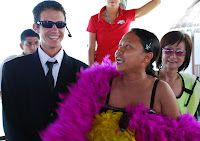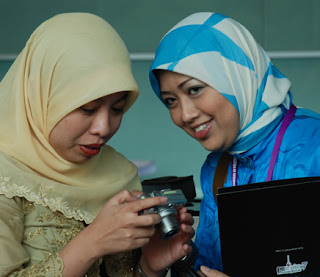 "Galle remains the best example of a fortified city built by Europeans in South and Southeast Asia " - statement from the ICOMOS recommendation for World Heritage List No 451, dated Dec 31, 1986.
"Galle remains the best example of a fortified city built by Europeans in South and Southeast Asia " - statement from the ICOMOS recommendation for World Heritage List No 451, dated Dec 31, 1986.The APSA 2007 Conference Organisers gave participants two choices for a post-conference tour - to the Ancient City of Sigiriya or Colombo. Only one registered for Colombo so that was cancelled. I could not take up the trip to Sigiriya because they will be back only at about 9 pm while my flight was 10 pm. I chatted with the people organising the trips and was convinced that I should go to Galle (pronounced "Gall" not "Gallee") because it is a World Heritage site. Eventually, Angelique (originally from Kerala, now in Cardiff) and her two sons joined me on the long journey to and from Galle.
Sanjeetwani, a recent planning graduate from the University of Moratuwa and now an instructor at her alma mater, was our guide for the day. She, like most (probably all) Sri Lankans I have met are extremely polite and even-tempered. I told her my goal that day would be to make her angry. She smiled and said "yes sir". I asked her to pray for the sun to come out so that my photos will look great, and she said "I will try sir". I also said I missed my noodles and she said she will try to find me some, sir. But honestly, even the hotel staff are very polite - even then I observed an overbearing foreign tourist telling the counter staff to make some copies of documents within "the next five minutes" (he was apparently annoyed with the Internet service). The journey to Galle took longer than expected (more than 3 hours I think) but it was bearable because Angelique and I were still fresh and had the energy to chat about academic stuff (what else?). I actually first heard her presenting a paper at the Hanoi APSA 2003 but we didn't get to talk until this trip.
 Along the way, the subject of toddy came up (I think it was a picture in a tourist guidebook showing ropes tied across coconut trees used for harvesting toddy). We all wanted to try, including Sanjeeni (who's father had not allowed her to try). The driver spotted a roadside vendor and we all excitedly went down to have a taste. But when we saw the condition of the wooden barrels used to store the toddy, we all decided against risking a stomach upset. The driver told us that they are all like that but getting a stomach upset is not a trivial matter when you are travelling (Terry McGee politely said "he had a reaction to the food" the morning after the Conference Dinner). Some of my fellow APSA colleagues actually travel with various medication, including for stomach upset, in their suitcases.
Along the way, the subject of toddy came up (I think it was a picture in a tourist guidebook showing ropes tied across coconut trees used for harvesting toddy). We all wanted to try, including Sanjeeni (who's father had not allowed her to try). The driver spotted a roadside vendor and we all excitedly went down to have a taste. But when we saw the condition of the wooden barrels used to store the toddy, we all decided against risking a stomach upset. The driver told us that they are all like that but getting a stomach upset is not a trivial matter when you are travelling (Terry McGee politely said "he had a reaction to the food" the morning after the Conference Dinner). Some of my fellow APSA colleagues actually travel with various medication, including for stomach upset, in their suitcases. One of the stops we made was at a Buddhist temple. The stopover itself was not very eventful but while waiting for the van to pick us up again, we observed two interesting phenomenon. The first was a group of school boys and girls visiting the temple (see picture on left). Nothing special about that until you notice that they are all Muslims students on a school field trip. It was a very powerful image of religious tolerance in Sri Lanka.
One of the stops we made was at a Buddhist temple. The stopover itself was not very eventful but while waiting for the van to pick us up again, we observed two interesting phenomenon. The first was a group of school boys and girls visiting the temple (see picture on left). Nothing special about that until you notice that they are all Muslims students on a school field trip. It was a very powerful image of religious tolerance in Sri Lanka.The other interesting phenomenon was that the road in front of the temples (actually there is another temple on the other side of the road) was embedded with lots of coins. Yes, embedded into the road. It is a Buddhist tradition to give donations when asking for blessings from Buddha. So how come the coins are on the road and not in the donation box? Sanjeetwani explained that villagers travelling on buses passing the temples would throw the coins out of the bus windows because the buses won't stop for them. But the most incredible thing is that nobody else will pick them up and put them in their own pockets. I didn't even see any beggars around the temples.
Now, Galle. We didn't get to see much of it because we spent so much time travelling and then it started to rain heavily. But through Sanjeetwani's connections we managed to visit the inside of one of the houses and even talked to the Chairman of the Galle Heritage Foundation. One thing which seems to stand out is that it seems to be the only place in the World where old Dutch architecture is still standing. So, the irony is that the Dutch (Government) is pumping a lot of money to help preserve its own heritage thousands of miles of away.
One of the questions the Chairman of the Foundation asked us was what we thought of Galle. I said that I could see some very nice buildings but also saw that there were restoration works which appeared to be a little insensitive to the architectural heritage (in terms of materials used for instance). He defended the Foundation's position in permitting those restorations and I guess they have a legitimate right to adopt a more dynamic approach to allow changes in culture, traditions and even current construction materials. For instance, did you know that the walls were constructed with corals and sand from the nearby beaches? That's causing a lot of problem for current restoration works. Galle has also become more predominantly Muslim who prefer to have houses which are not so open. But things can get out of hand like the foreigner who was refused permission to put a swimming pool in his house but did it anyway. When the enforcement people came to demolish the pool they demolished some parts of the old heritage walls as well. Sanjeetwani can just look at the front of the building and know whether a foreigner has bought over the house and made changes out of character with the original. It seems that after the Tsunami, many foreign relief workers have taken a liking to Galle but are not too sensitive to the architectural heritage.
 On the left is a house which has been restored but I felt it was not very sensitively carried out (note the gutter and sunshade and absence of a deep verandah in front)
On the left is a house which has been restored but I felt it was not very sensitively carried out (note the gutter and sunshade and absence of a deep verandah in front)In the middle is a rundown courtyard house
Then there's the problem of guidelines being too restrictive. We visited a house which is leaking all over the place and the wooden beams and timber floors are rotting away. The occupant (who's father operated a guest house from that building) claimed that the current owner refused to allow him to renovate or restore the house. There was also claims that the Authorities and the owner are at loggerheads, each with their own ideas of how to restore the building.
BTW, we had Chinese fried noodles (4 or 5 huge plates) for lunch in a nice restaurant in Galle. The restaurant was nice, but the noodles ... emmph, it was a little too much and not Chinese enough. After that, we were off to some souvenir shopping. And then Sanjeetwani asked whether it was OK if she did not accompany me to the airport (her family has a house in Galle and her father is a tea farmer) - I told you they are just really polite. I said "yes, it is perfectly alright!" - what else did you think I would have said?. If the situation were reversed, I would probably have told my guest "hey, this is where take off, have a nice journey, see you again".
The journey back to Colombo was uneventful - because we were all tire out and trying to sleep, which was difficult because of the not so comfortable seats and lack of air-conditioning. By the time we reached Colombo to drop off Angelique and sons, I was quite thoroughly numb but nothing compared to the next one and half hour ride to the airport which I can only describe as noxious. My driver suddenly became a demon on the road, driving fast, zigzaging in and out of traffic and persistently beeping on the horn as though telling everyone to make way for a VVIP. When we reached the airport, he pointed to his watch to say it was 7 pm and we are at the airport. Then I understood. He must have somehow got the impression I had to reach the airport by 7 pm. Lesson learnt? People in Sri Lanka take their promises seriously.
So I spent like 7 hours (or more) on the road to spend perhaps only 2 hours in Galle. Wish I had more time to walk and absorb the streets of Galle. I slept throughout my plane ride from Colombo via Male to KL, skipping all the meals and then more sleep back home in Air Tawar.
Incidentally, did you know that Sri Lanka has 6 World Heritage Sites?
Happy 50th Birthday Malaysia









































